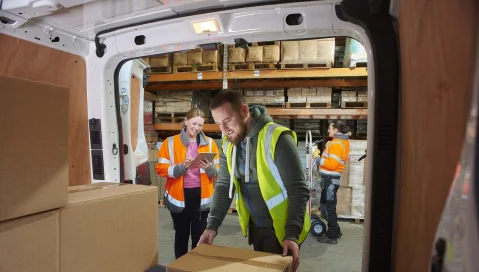The Battle Is on for Last Mile Logistics—How to Come out a Winner
The Battle Is on for Last Mile Logistics—How to Come out a Winner
The Battle Is on for Last Mile Logistics—How to Come out a Winner
12 Jul 2022
Aptean Staff Writer
For fleet owners and dispatch managers, last-mile logistics is crucial—but it is expensive. The final mile of deliveries comprises the costliest leg, eating up about 53% of the total cost of transportation. That means that optimizing resources for last mile delivery needs to be the primary focus for your fleet. At the same time, you can also transform your operations to embrace last mile logistics. What if I told you that it could become a source of competitive advantage for your fleet?
In the guide below, we’ll give you a brief overview of the last-mile logistics segment, how it’s changing and then walk you through how to use last mile as a competitive differentiator for your enterprise. Let’s get started.
What Is Last Mile Logistics?
The easy definition is that last mile logistics refers to just that—the final mile of delivery. However, for logistics companies, it encompasses much more than that. It involves a complex planning process, multiple people and could entail driving any distance from a few blocks to 100 miles depending on the size of the area. For urban areas with a high population density, you must also account for heavy traffic, city and state emissions restrictions, and even noise ordinances. Last mile delivery includes multiple stops with smaller drops and often involves a lot of walking for the driver.
The rise of Amazon marked a commensurate rise in customer expectations—same-day and next day shipping is the new norm. While this is a boon to consumers, it puts a strain on a trucking industry that is already overtaxed with rising fuel prices and driver shortages. Nonetheless, smart trucking companies must embrace last mile logistics and find a way to make their last-mile deliveries both efficient and cost-effective. It’s important because whoever can leverage their last-mile delivery capabilities into the home delivery vertical will win the last mile battle.
Why Capitalize on Last-Mile Logistics?
Here’s an interesting statistic. The last mile logistics market segment is expanding rapidly, with analysts projecting growth of about $144 billion by 2026. Moreover, customer expectations have skyrocketed—the average consumer expects rapid-fire delivery, as well as full visibility into that delivery.
For the average logistics company, the goal of a successful last mile delivery strategy is to improve customer service by offering a choice of delivery options, while still optimizing route efficiency. This means that dispatch managers must create routes that are both viable and cost effective—a tall order.
What does this mean for trucking companies? It means that those logistics companies that can pivot and concentrate on this crucial part of the delivery process could potentially open a powder keg of profits.
Rise to the Challenge: Issues with Last Mile Logistics (and How to Meet Them)
Let’s face it—most of your logistics giants, like Swift Transportation, already have a dedicated last-mile division. However, even small- to mid-size carriers can compete with these heavyweights. Last mile optimization is imperative for every logistics company, so if you want to compete in the growing delivery space, you have options. Home delivery isn’t going anywhere and there is room in the market for carriers of all sizes. It’s simply about addressing the needs of your market and using the right tools to find a niche to match demand.
While it’s true that fuel prices are climbing, the good news is that same-day delivery generally commands a 25 to 30% surcharge, which should not only offset the higher gas usage associated with urban (and suburban) deliveries but build in a tidy profit for your enterprise. The key to success in this growing vertical is robust technology and flexibility.
Challenge #1: Knowing Your Costs
Using advanced routing software, you can run a cost-to-serve analysis. If you haven’t done one before, now is the perfect time. Advanced routing software can not only help you run that analysis, but it also allows you to calculate the exact impact of any changes on delivery costs and margins.
By using complex what if models, your routing software will help you determine if this type of business model is viable and profitable. In addition, route planning software helps you determine and sell your services at a fair price, because it gives you clear, concise cost data which you can leverage into discussions with prospective customers. In addition, once you’ve looked at the market, you can test out concepts to build out your distribution network before you ever put a truck on the road.
For instance, let’s say that you’re a distributor of high-end gourmet items to restaurants. You discover that many consumers would like to get these items delivered to their homes, as well. You run an analysis in your software and find out the best way to make it work. You can even look at your sales to find areas of lighter volume and try to reach those customers. The beauty of the last mile business is that it is almost completely industry agnostic. Whatever the product or service, there is a market for it in consumer and B2B deliveries.
Aptean’s advanced routing software can help you make the most of the resources you already have and give you the data you need to break into this growing market segment. Even without using business modeling functions, routing software can reduce operating costs an average of 10-30% in the first few months and deliver a full Return on Investment (ROI) in 6 months or less. This means that you will have the money you need to put back into your enterprise and invest in new resources and hire new drivers should you need to. Regardless, the benefits of robust route optimization software could be transformative.
Challenge #2: Preparing for Contingencies
Your fleet needs to be prepared for any eventuality, and America’s roadways are never predictable. Between traffic, construction, bad weather, special events and the like, your drivers could experience delays at any turn, so you need to have strategies in place should delays occur. Route optimization software will not only help you avoid holdups, but it can also lead to happier customers.
The routing software, paired with in cab telematics, gives your dispatch team full execution visibility. They’ll know if drivers are following the planned routes and whether they are making unnecessary stops. Detention and delays lead to missed deliveries and can have a ripple effect on the entire day’s schedule. Aptean’s routing software provides the most agile approach for last-mile deliveries because your dispatch office can respond to changing conditions by re-allocating loads as the day progresses.
Furthermore, live route execution lets you manage both planned and last-minute, dispatched orders. With this system, you can revise the route and communicate with your driver. Then, the dispatcher can reshuffle the route based on the latest data, creating a more agile, customer-focused operation.
Challenge #3: Maintaining Full Visibility
In last-mile deliveries, visibility is imperative. The customer not only wants to know where their delivery is, but exactly when it will arrive. And if there are any issues, they want to be told immediately. Advanced delivery route planning software allows you to give customers an accurate, real-time ETA. In an era when same-day or next-day delivery is the new service standard, full route visibility, from depot to delivery, is an invaluable must-have.
Aptean Proof of Delivery software, coupled with the Aptean Home Delivery module, offers real-time updates to both you and your customers directly. If you have customers waiting for a delivery, but they know it’s going to be late, you can avoid the mountains of paperwork and phone calls. Of course, being able to give customers timely updates on delivery progress is important, but with the complete visibility advanced routing software provides, you may be able to spot potential problems and proactively address them before they occur—stopping a customer complaint in its tracks.
For your dispatch team, the benefits of full visibility are endless, but particularly if you are running delivery operations from multiple distribution centers. Most routing software solutions treat each distribution center (DC) as a separate entity when planning routes and delivering orders. However, Aptean’s advanced delivery route planning software has multi-depot routing functionality that allows your team to plan and report across an entire region.
To gain competitive advantage in the ongoing battle for the last mile logistics market, we need to change our thinking. Last mile operations don’t need to be a drain on your profits; instead, look at the last mile as a driver for competitive advantage.
Intelligent, optimized routing not only helps you run a tighter ship, but it can also help you gain market share because if you don’t use every tool at your disposal, you can be sure your competitors will. Routing and scheduling software is the weapon you need to make your fleet battle-ready.
Aptean’s Routing & Scheduling, Proof of Delivery, and Home Delivery software helps transportation companies like yours maximize efficiency and profitability in logistics operations. Our industry experts can help your enterprise deliver the perfect last mile experience to customers. Find out how, now.
Related Articles


Ready to start transforming your delivery business?
We’ve got the specialized TMS solutions you need to conquer your industry challenges.






